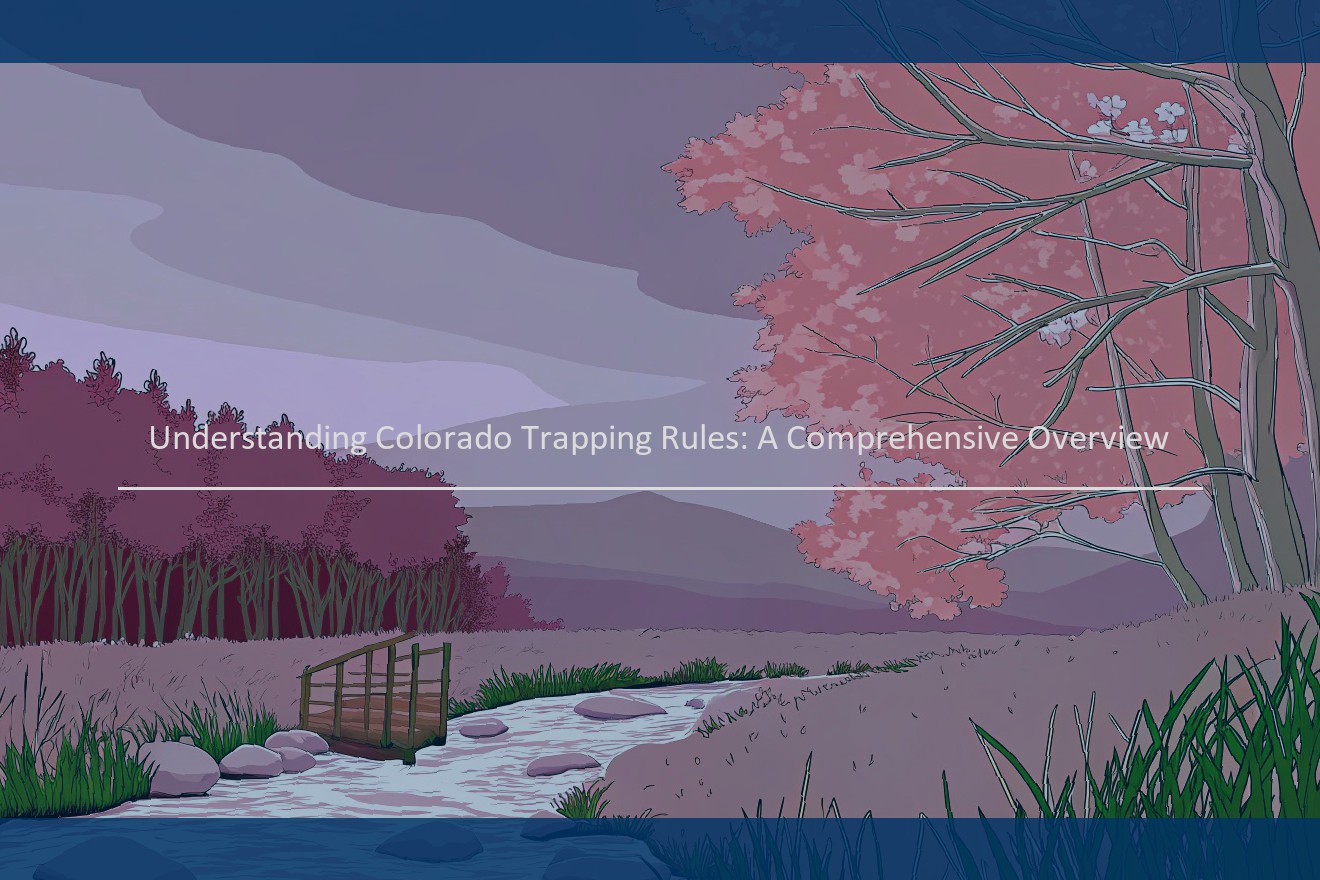What You Need to Know About Colorado Trapping Laws
Trapping is not just a sport; in Colorado, it’s an important tool for wildlife management and species conservation. As such, it’s no surprise that the state has a series of laws and regulations governing the practice to ensure it is done ethically and humanely, so that the populations of certain wildlife can be stabilized.
Because trapping isn’t as popular an outdoor activity as hunting or fishing, many people are not familiar with the various Colorado trapping laws or even what trapping consists of. Because of this, some individuals may inadvertently and unknowingly commit offenses that have penalties, from fines to loss of privileges. Understanding these laws is extremely important if you plan to trap wildlife in Colorado .
Like most outdoor sports and activities, trapping has its own set of rules and regulations that govern the practice in ways that keep populations of wildlife in check. The law regulating trapping in Colorado is the Trapping and Furbearer Hunting Act of 2017. This law keeps the trapping experience as safe as possible for trappers while also attempting to minimize any impact the practice has on wildlife. It also helps make tracking and monitoring of furbearers in the state possible.
Trapping is largely regulated by the Colorado Parks and Wildlife (CPW). It requires a license for any kind of big game hunting (including mountain lions and bobcats). No license is required to trap furbearers, although a Big Game Managers List Permit is required for animals included on this list.
Colorado Trapping Laws and Regulations
For those seeking to trap in Colorado, adherence to legal requirements is not merely a recommendation: it is a legal obligation of every individual who engages in this activity. In the American West – including Colorado – the notion of personal responsibility is deeply embedded in the region’s culture and character. Similarly, any person that would own a piece of land big enough to imprison a wild animal, has a personal responsibility to observe the local laws governing those lands. These laws apply to small back yards, mountain cabins, and expansive, previously untouched, ranches or hunting lodges. Colorado is unique among the states in that roughly 64% of the land located within its borders is owned by the federal government. Private lands have a legal requirement to respect the federal government’s jurisdiction when it comes to how wildlife within those lands may be managed. Title 33 of the Colorado Revised Statutes (C.R.S. 33) gives the Colorado Parks and Wildlife Department (CPWD) "full power and authority to adopt rules governing…hunting, trapping and fishing in districts, counties, cities or other municipalities where such action of the Commission is needed to prevent the deterioration of wildlife resources." When a landowner or lessee in Colorado wishes to trap wildlife within their land, the law requires that they first assess whether such activity runs afoul of the CPWD’s rules and regulations.
With regard to licensing, C.R.S. 33-4-102 addresses those persons necessary qualifications required to obtain a license to hunt, trap, or fish within the state. Specifically, the Department issues three types of licenses. The first is the resident hunting or fishing license. A resident must be twenty-one years of age to obtain such licenses. The second type of license is also hunting or fishing license, but open to non-resident individuals aged twelve through juvenile (under the age of thirty under certain circumstances). The third license is one to harvest wildlife, possess wildlife, or both. A person eighteen years of age is eligible to obtain a license to harvest wildlife. A person fifteen years of age is eligible for a juvenile harvesting license.
While not required to take animals in the course of their normal agricultural practices or normal operations, owners of lands adjacent to or encumbered by a public road must possess a CPW issued permit while trapping on their lands. Such permits are available through the CPW at no charge. Individuals over the age of twelve may possess a permit for the transportation of wildlife taken in accordance with the law.
These statutory provisions have been supplemented by numerous rules and regulations. The CPWD also issues weekly newsletters that keep interested parties informed of any changes that might affect them. All of these resources – not to mention the Colorado Revised Statutes – are available online.
Permissible Trapping Devices
Colorado law permits limited use of traps as specified in C.R.S. 33-6-122 (2)(b). By law, they may be used to capture beaver, raccoons, weasels, spruce hen, snowshoe hare, and coyotes, only during the following times: 2 weeks prior to hunting season and from December 15 to April 15. Traps must be "leghold-type traps." "Leghold-type traps" are defined by statute as any "trap that is designed to hold quarry by the foot." Traps must measure no more than 8 inches across inside jaws. Traps must be set 50 yards away from any road, fence or sea of water that covers more than ten acres in size. The law states that it is illegal to trap "for purposes of taking coyotes that landowners may allow to be taken on their land," unless a licensed person "obtains permission from the landowner or an agent of the landowner." However, no written permission is required. For people who want to avoid animal suffering, there are many humane traps that meet statutory requirements. Humane traps are regulated, and as with all traps, must be inspected every 24 hours to ensure that animals caught in the traps are left to suffer as little as possible.
Closed Seasons and Species Prohibitions
In addition to the restrictions on location and types of traps, Colorado trapping laws also regulate when it is legal to trap. These seasonal regulations vary according to the region in which you live. For example, in the northwest corner of the state, a special license is required for trapping waterfowl year-round. Those watersheds are listed in the Colorado Parks and Wildlife Fishing brochure.
The seasonal regulations also vary depending on the species that may be trapped. All fur-bearing animals are eligible for trapping from Nov. 1 of one year until March 15 the next. Exceptions are made for endangered species and moose, which cannot legally be trapped at all.
No trapping of squirrels is permitted from October to March. No trapping of red foxes is allowed from March 16 to July 14. Trapping Steller’s eiders is only permitted between Nov. 1 and Jan. 31 in the southern portion of the state, while trapping Steller’s eiders in the western portion of the state is prohibited.
Trapping on Private vs. Public Lands
Trapping regulations differ from private land to public land. Private land has no special rules as far as city or county. A landowner can give anyone permission to trap. The only requirement is that the trapper must inform the County Sheriff of the opportunity to trap there . Public land, such as state parks and National Forests, regulates trapping much more closely. Some require permits while others do not. The Colorado Parks and Wildlife Department recommends checking the website for details because they are different from park to park and forest to forest.
Consequences for Offenses
Violations of trapping laws can have harmful effects on wildlife and the environment in Colorado. The following is a summary of penalties and fines enacted by the Colorado legislature and the parks, wildlife and administrative codes.
Trapping without a license (CRS § 33-7-201) and taking a protected mammal without a permit (C.R.S. § 33-6-109) are both Class B misdemeanors, with penalties consisting of up to six months in jail and a fine of up to $1,000.
Crimes involving taking, possession, and sale of animals classified as small game are generally Class 2 misdemeanors (CRS 33-6-116), unless they involve catchable waterfowl, which is considered a Class 1 misdemeanor (CRS 33-6-118).
Violations of illegal traffic regulations (C.R.S. § 33-6-105) result in a fine of $50 to $200 for the first offense and $200 to $500 for the second or subsequent offenses. Additionally, a person who committed an offense under this statute also is responsible for the replacement value of the unlawfully taken animals, pursuant to C.R.S. § 33-6-121.
Crimes associated with unlawful methods of taking an animal are considered Class 2 misdemeanors if the penalties do not otherwise apply. (C.R.S. § 33-6-119). Unless otherwise provided, an unlawful take of a mountain lion or mountain goat from the wrong area results in a $10,000 fine. (C.R.S. § 33-6-121).
Crimes relating to taking, possession, and sale of animals classified as big game are generally Class 5 felonies if neither the Colorado Criminal Code nor the game statutes otherwise specify the penalty (C.R.S. § 33-6-114), but this classification changes to a Class 4 or felony for repeated violations. (C.R.S. § 33-6-120).
Hunting violations, especially illegal traffic violations, of criminal offenses are enhanced civil charges, meaning the penalties increase substantially with each subsequent violation. These violations are handled by a hearing before an administrative law judge, rather than in the Colorado criminal courts. Penalties for the first violation can include 30 days to a year of annual big game licenses for hunting and/or fishing, or the cost of a new hunting or fishing license, depending on the type of violation. For subsequent violations, the penalty increases to a minimum of six months of annual big game hunting and/or fishing licenses. (C.R.S. §§ 33-6-104; 33-6-110).
Possession, sale, and use of prohibited methods of taking an animal, or destruction of wildlife is a Class 2 misdemeanor unless a fine does not otherwise apply. (C.R.S. § 33-6-119).
Conservation and Ethics
In Colorado, as in many regions with a diversity of wildlife, the conservation of animal populations and their natural habitats is not only a legal obligation but a moral one as well. Understanding trapping laws and how they fit into the broader conservation framework is essential for anyone involved in this practice.
Good trapping practices do not just aim to control wildlife populations; they also contribute to sustainable levels that maintain ecosystem balance. Certain species may require population controls to limit the spread of disease or the overconsumption of vegetation. By trapping these animals, individuals help prevent problems that could otherwise cascade through the ecosystem.
Moreover, conservationists view trapping as a tool for preserving other species and habitats. For example, reducing populations of beavers or raccoons, which can damage tree growth or pollute water sources , can actually create an environment that benefits birds or other small mammals.
The ethical considerations of trapping in Colorado go hand in hand with conservationist ideals. This means ensuring that the trapping process minimizes suffering and addresses concerns about the safety of pets and livestock. Responsible trappers must abide by rules that govern the use of traps and the conditions in which they are used.
In addition, ethical trapping is about being responsible stewards of the land. The Colorado Division of Parks and Wildlife encourages trappers to practice a philosophy of care and respect for the animals they trap. This includes humane dispatching of trapped animals and ensuring that they are kept in appropriate conditions if they are alive at the end of the trapping period.
Understanding how ethical practices can support both conservation and animal welfare is crucial for those who engage in trapping in Colorado. Such understanding helps to produce a new generation of responsible trappers who can be ambassadors for wildlife conservation.



+ There are no comments
Add yours